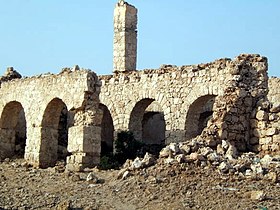Adal Sultanate

The Adal Sultanate (Somali: Adaal, Ge'ez: አዳል ʾAdāl, Arabic: عدل) (c. 1415 - 1555) was a province-cum-sultanate located in present-day northwestern Somalia, southern Djibouti, and the Somali, Oromia, and Afar regions of Ethiopia. At its height, the sultanate controlled large portions of Ethiopia and Somalia.
Ethnicity
| History of Somalia |
|---|
 |
|
|
There is still debate over the ethnic composition of the kingdom. I.M Lewis states,
- Somali forces contributed much to the Imām’s victories. Shihab ad-Din, the Muslim chronicler of the period, writing between 1540 and 1560, mentions them frequently (Futūḥ al-Ḥabasha, ed. And trs. R. Besset Paris, 1897.). The most prominent Somali groups in the campaigns were the Samaroon(Dir),Geri, Marrehān, and Harti---all Dārod clans. Shihāb d-Dīn is very vague as to their distribution and grazing areas, but describes the Harti as at the time in possession of the ancient eastern port of Mait. Of the Isāq only the Habar Magādle clan seem to have been involved and their distribution is not recorded. Finally several Dir clans also took part.[1]
This finding is supported in the more recent Oxford History of Islam:
The sultanate of Adal, which emerged as the major Muslim principality from 1420 to 1560, seems to have recruited its military force mainly from among the Somalis.[2]
Lewis, on the other hand, notes that the Imam's origins are unknown.[3] There is also evidence that the sultanate may have been largely Afar in nature. Ewald Wagner connects the name ʿAdäl with the Dankali (Afar) tribe Aḏaʿila and the Somali name for the clan Oda ʿAlï, proposing that the kingdom may have largely been composed of Afars.[4] Although Afars constituted a significant part of Adal, Didier Morin notes that "the exact influence of the ʿAfar inside the Kingdom of `Adal is still conjectural due to its multiethnic basis."[4] Nevertheless, Franz-Christoph Muth identifies Ahmad ibn Ibrihim al-Ghazi as Somali.[5]
Ethiopian Province
Prior to 1288, Adal was a Muslim province of Christian Solomonic Ethiopia. At some point afterwards, the province rebelled and had to be reconquered under the Ethiopian negusä nägäst Amda Seyon in his 1332 campaigns. During the same campaign, the Sultanate of Shewa and the smaller Sultanate of Ifat, controlling a few trading ports on the coast including Zeila were also conquered. Adal was later controlled by Ifat, but it eventually became independent in its rebellion against Amde Seyon, but had to surrender after the death of its king and the conquest of its capital, Talag, eventually ending in Jamal ad-Din of Ifat's death and the sultanates' subjugation.[6] In either 1403 or 1415, the Ethiopians reconquered Ifat once again, which had recently rebelled against the Emperor, and defeating its armies under its sultan, Sa'ad ad-Din II. Sa'ad ad-Din was chased throughout the kingdom, with the Ethiopian Emperor (either Dawit I in 1403 or Yeshaq I in 1415) eventually conquering the port of Zeila and killing him.[7] As a result, the royal Walashma family had to flee to Yemen to avoid being caught and killed. When they later returned, however, their head took the title "Sultan of Adal," rather than "Sultan of Ifat," indicating that Ifat was a part of Adal (also called Barr Sa'ad ad-Din in the former ruler's honor, considered a martyr) instead of the reverse as in the past.[7]
Invasion of Ethiopia
In the mid-1520s, Imam Ahmad ibn Ibrihim al-Ghazi conquered Adal and launched a holy war against Christian Ethiopia, which was then under the leadership of Lebna Dengel. Supplied by the Ottoman Empire with firearms, Ahmad was able to defeat the Ethiopians at the Battle of Shimbra Kure in 1529 and seize control of the wealthy Ethiopian highlands, though the Ethiopians continued to resist from the highlands. In 1541, the Portuguese, who had vested interests in the Indian Ocean, sent aid to the Ethiopians in the form of 400 musketeers. Adal, in response, received 900 from the Ottomans.
Imam Ahmad was initially successful against the Ethiopians while campaigning in the Autumn of 1542, killing the Portuguese commander Cristóvão da Gama in August that year. However, Portuguese musketry proved decisive in Adal's defeat at the Battle of Wayna Daga, near Lake Tana, in February 1543, where Ahmad was killed in battle. The Ethiopians subsequently retook the Amhara plateau and recouped their losses against Adal. The Ottomans, who had their own troubles to deal with in the Mediterranean, were unable to help Ahmad's successors. In 1577, the capital of the Adal Sultanate was moved from Zeila to Harar, and a sharp decline in Adal's power followed.
The Gadaa Expansion
After the conflict between Adal and Ethiopia had subsided, the conquest of the highland regions of Ethiopia and Adal by the Oromo (namely, through military expansion and the installation of the Gadaa socio-political system) ended in the contraction of both regional powers and changed the dynamics of the region for centuries to come. In essence, what had happened is that the populations of the highlands had not ceased to exist as a result of the Gadaa expansion, but were simply incorporated into a different socio-political system.
Notes
- ^ I.M Lewis, "The Somali Conquest of Horn of Africa," The Journal of African History, Vol. 1, No. 2. Cambridge University Press, 1960, p. 223.
- ^ John L. Esposito, editor, The Oxford History of Islam, (Oxford University Press: 2000), p. 501
- ^ Lewis, "The Somali Conquest of the Horn of Africa," p. 223f.
- ^ a b Herausgegeben von Uhlig, Siegbert, Encyclopaedia Aethiopica. Wiesbaden:Harrassowitz Verlag, 2003, pp.71
- ^ ibid, pp. 155
- ^ ibid, pp.71
- ^ a b ibid.
